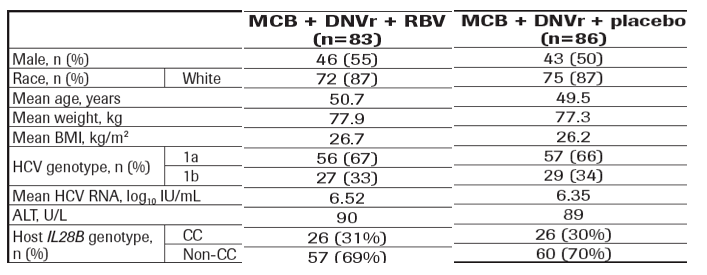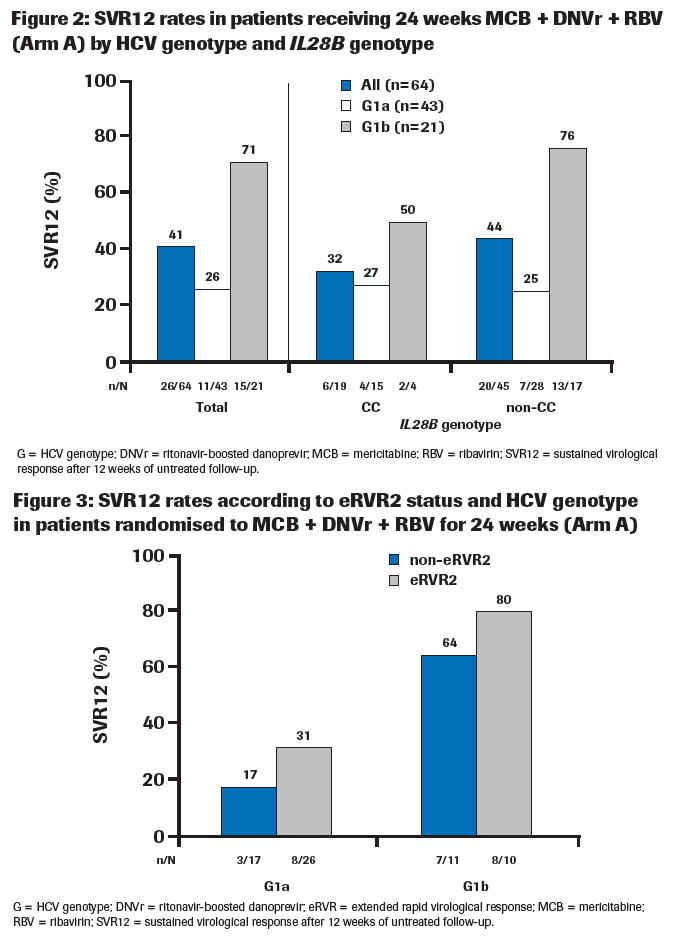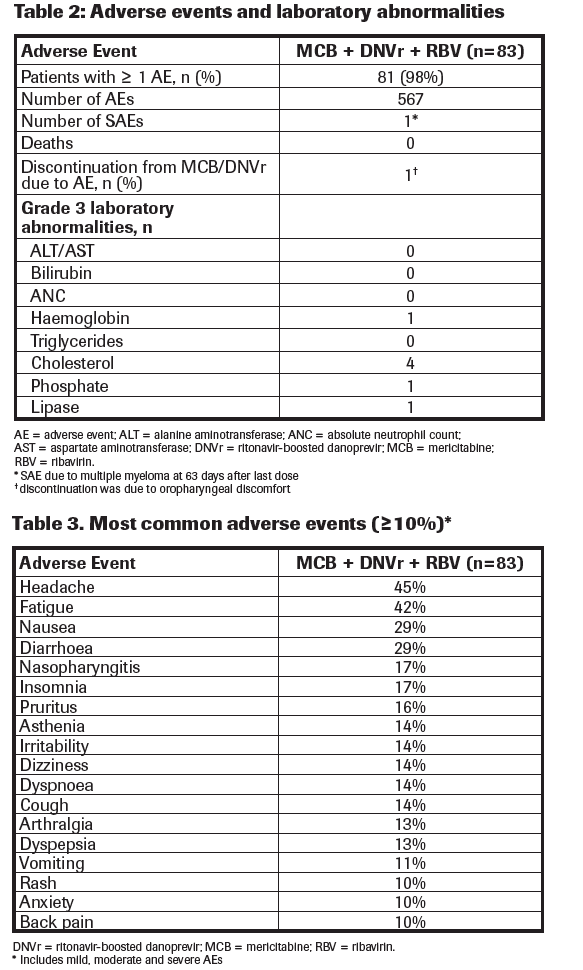 |
 |
 |
| |
INTERFERON-FREE TREATMENT WITH A COMBINATION OF MERICITABINE AND DANOPREVIR/R WITH OR WITHOUT RIBAVIRIN IN TREATMENT-NAIVE HCV GENOTYPE 1-INFECTED PATIENTS
|
| |
| |
Reported by Jules Levin
EASL 2012
E.J. Gane,1 P. Pockros,2 S. Zeuzem,3 P. Marcellin,4 A. Shikhman,5 C. Bernaards,6 E. Yetzer,6 N.S. Shulman,6 X. Tong,5 I. Nájera,5 A. Bertasso,5 J. Hammond,5 S. Stancic5
1Auckland Clinical Studies, Auckland, New Zealand; 2Scripps Clinic and Scripps Translational Science Institute, La Jolla, CA, USA; 3J. W. Goethe University Hospital, Theodor-Stern-Kai, Frankfurt, Germany; 4Hôpital Beaujon, Clichy, France; 5Roche, Nutley, NJ, USA;
6Genentech, South San Francisco, CA, USA
from Jules: again here viral breakthrough, likely similar to breakthrough seen in Mericitabine 24week SVR study, associated with medicitabine, appears to cause viral breakthroughs here as well. The new boosted danoprevir/r data reported at this meeting is very good though with 90-96% SVR rates using the high-dose 200/100 regimen combined with peg/rbv. Again, a message I've been saying is as we move forward we would like to use the best individual oral HCV drugs in combinations and boosted danoprevir/r is one of them.
EASL: APID AND SUSTAINED ACHIEVEMENT OF UNDETECTABLE HCV RNA DURING TREATMENT WITH RITONAVIR-BOOSTED DANOPREVIR/PEG-IFNα-2A/RBV IN HCV GENOTYPE 1 OR 4 PATIENTS: DAUPHINE WEEK 36 INTERIM ANALYSIS - (04/22/12)
EASL: RITONAVIR SUBSTANTIALLY REDUCES REACTIVE METABOLITE FORMATION OF THE HCV PROTEASE INHIBITOR DANOPREVIR BOTH IN VITRO AND IN VIVO - (04/21/12)
"Breakthrough rates
· In total, among all patients who received at least one dose of study medication, 26 patients experienced breakthrough: 8 in Arm A (8/83; 9.6%) and 18 in Arm B (18/86; 20.9%).
· When evaluated by HCV genotype, breakthrough rates were higher among HCV G1a patients (Arm A: 6/56; 11%; Arm B: 15/57; 26%) compared to G1b patients (Arm A: 2/27; 7%; Arm B: 3/29; 10%)."
CONCLUSIONS
· In G1b patients, 24 weeks of MCB in combination with DNVr and RBV yielded an SVR12 rate of 71%, while in G1a patients the SVR12 rate
was 26%.
· Higher SVR12 rates were reported among patients who were rapid responders, i.e. those who achieved an eRVR2. Among patients with an
eRVR2, 80% with G1b and 31% with G1a achieved SVR12.
· IL28B genotype (CC and non-CC) appeared to have less impact on SVR12 rates relative to differences observed between HCV G1a and G1b patients.
· Among patients not receiving RBV, breakthrough rates were higher indicating that RBV still plays an important role in preventing viral breakthrough.
· All patients with a confirmed viral breakthrough showed DNV-resistant variants, while only one patient showed the NS5B S282T polymerase
mutation associated with resistance to MCB.
· Combination of MCB, DNVr and RBV is safe and well tolerated, resulting in no significant cytopenias, no treatment-emergent alanine
aminotransferase elevations or any new signals with combination therapy.
· In view of its promising efficacy in G1b patients (>70%) and its good tolerability and safety profile, this interferon-free regimen warrants further study.
INTRODUCTION
· The hepatitis C treatment landscape is rapidly evolving. The recent regulatory approval of first-generation protease inhibitors has resulted in a new standard of care for genotype 1 patients, consisting of peginterferon alfa/ribavirin (RBV) in combination with telaprevir or boceprevir, with sustained virological response (SVR) rates of 68-75% achievable in treatment-naive patients.[1-3]
· However, safety and tolerability remain suboptimal. The benefits of adding one direct-acting antiviral agent (DAA) to peginterferon alfa/RBV remain limited due to the underlying safety and tolerability issues associated with interferon-based treatment.
· An all-oral, interferon-free DAA combination treatment would fill an unmet medical need and potentially further change the treatment paradigm.[4]
· Two DAAs currently in phase II clinical development are mericitabine (MCB) and danoprevir (DNV; RG7227).
· MCB is a selective and non-cytotoxic hepatitis C virus (HCV) polymerase inhibitor which is active against all HCV genotypes and has a high barrier to resistance.[5-7]
· DNV is a potent, macrocyclic, HCV protease inhibitor that has equipotent activity against HCV genotypes 1, 4 and 6 in vitro.[8,9]
· The phase I INFORM-1 study demonstrated that treatment with a combination of these two DAAs for 13 days resulted in significant
reductions in HCV RNA in both treatment-naive and prior null responders and was well tolerated.[4]
· Co-administration of ritonavir with lower doses of DNV has since been shown to decrease the overall exposure of DNV while maintaining potent antiviral activity.[10]
· The phase IIb INFORM-SVR study is investigating the safety and efficacy of response-guided treatment with MCB in combination with
ritonavir-boosted DNV (DNVr) with and without RBV for 12 or 24 weeks in treatment-naive patients with genotype (G) 1 chronic HCV infection.
· Here, results from a 12-week post-treatment interim analysis of the INFORM-SVR study are presented.


RESULTS
Patients
· A total of 169 patients were randomised to treatment (Arm A n=83; Arm B n=86) and received at least one dose of study medication.
· Demographics were balanced between arms (Table 1).
Table 1: Baseline characteristics of the study population

ALT = alanine aminotransferase; BMI = body mass index; DNVr = ritonavir-boosted danoprevir; MCB = mericitabine; RBV = ribavirin.
· Randomisation to 12 weeks of treatment in Arm A and to the whole of Arm B was stopped prematurely due to high relapse rates, and patients in Arm B were offered follow-on with peginterferon alfa-2a (40KD)/RBV therapy.
· As a result, only 20/169 patients were randomised to 12 weeks of treatment (Arm A n=17; Arm B n=3) and thus, for efficacy analyses, Arm A (24 weeks of treatment), is the key group analysed here (n=66).
Efficacy
· Among patients randomised to Arm A for 24 weeks (n=66), two patients were excluded from the present efficacy analysis; one patient discontinued for reasons other than virological breakthrough or an adverse event (AE) and one patient was lost to follow-up.
· The efficacy population thus consisted of 64 patients who received MCB combined with DNVr and RBV for 24 weeks; 43 patients with HCV G1a and 21 with HCV G1b.
· SVR12 rates for G1a and G1b patients receiving 24 weeks of MCB plus DNVr and RBV treatment are presented in Figure 2.
- Overall, 41% of patients achieved SVR12 (26/64; 95% CI 28-53). However, SVR12 rates were considerably higher among patients with HCV G1b (71%; 95% CI 50-92) compared with patients with G1a infection (26%; 95% CI 12-39)
- When SVR12 rates were stratified according to IL28B genotype (CC and non-CC), 32% of patients with IL28B CC genotype, and 44% with non-CC genotype achieved SVR12
- In G1a patients, SVR12 rates were similar irrespective of IL28B genotype. However, in G1b patients the number of IL28B CC patients was too small (n=4) to allow a meaningful comparison to patients with IL28B non-CC genotype.
· Among patients in Arm A treated with MCB combined with DNVr and RBV for 24 weeks, 60.5% (26/43) of HCV G1a-infected patients achieved an eRVR2 compared to 47.6% (10/21) of patients with HCV G1b infection.
· Among the patients achieving an eRVR2, 31% (8/26) of G1a and 80% (8/10) G1b achieved an SVR (Figure 3).

Breakthrough rates
· In total, among all patients who received at least one dose of study medication, 26 patients experienced breakthrough: 8 in Arm A (8/83; 9.6%) and 18 in Arm B (18/86; 20.9%).
· When evaluated by HCV genotype, breakthrough rates were higher among HCV G1a patients (Arm A: 6/56; 11%; Arm B: 15/57; 26%) compared to G1b patients (Arm A: 2/27; 7%; Arm B: 3/29; 10%).
· DNV resistance mutations were detected by population sequencing in 25 patients at virological breakthrough; sequencing could not be performed in one G1a patient due to low viral load.
- The NS3 R155K amino acid change was the only known DNV resistance mutation detected at the population level in 16 patients (14 G1a, two G1b)
- R155K + V36M/A was observed in five G1a patients
- D168T was observed in one G1b patient
- D168E + V36V/G was observed in one G1b patient
- One patient (GT1a) had a dual resistant virus to MCB and DNV, bearing substitutions NS5B S282T and NS3 R155K
- R155K/Q was observed in one G1b-infected patient
· The dual resistant virus reverted to wild type by week 12 of follow-up (T282S at week 8 and K155R at week 12); clonal sequencing and/or ultra-deep pyrosequencing analyses are ongoing.
Safety
· Treatment with MCB in combination with DNVr and RBV was safe and well tolerated and no safety concerns were identified (Tables 2 and 3).
· No serious AEs were reported during treatment in Arm A.
· No Grade 4 laboratory abnormalities were reported (Table 2).

References
1. Poordad F, McCone J Jr, Bacon BR, et al. Boceprevir for untreated chronic HCV genotype 1 infection. N Engl J Med 2011; 364: 1195-206
2. Jacobson IM, McHutchison JG, Dusheiko G, et al. Telaprevir for previously untreated chronic hepatitis C virus infection. N Engl J Med 2011; 364: 2405-16
3. Sherman K, Flamm SL, Afdhal NH, et al. Response-Guided Telaprevir Combination Treatment for Hepatitis C Virus Infection. N Engl J Med 2011; 365: 1014-1024
4. Gane EJ, Roberts SK, Stedman CA, et al. Oral combination therapy with a nucleoside polymerase inhibitor (RG7128) and danoprevir for chronic hepatitis C genotype 1 infection (INFORM-1): a randomised, double-blind, placebo-controlled, dose escalation trial. Lancet 2010; 376: 1467-75
5. Ali S, Leveque V, Le Pogam S, et al. Selected replicon variants with low-level in vitro resistance to the hepatitis C virus NS5B polymerase inhibitor PSI-6130 lack cross-resistance with R1479. Antimicrob Agents Chemother 2008; 52: 4356-69
6. Leveque V, Fung A, Le Pogam S. et al. Nucleoside analog R7128, a prodrug of PSI-6130, shows inhibition potency across HCV genotypes 1-6 in vitro. Poster P-215 presented at the 16th International Symposium on Hepatitis C Virus and Related Viruses, Nice, France; 2009. Poster 215
7. Reddy R, Rodriguez-Torres M, Gane E, et al. Antiviral activity, pharmacokinetics, safety, and tolerability of R7128, a novel nucleoside HCV RNA polymerase inhibitor, following multiple, ascending, oral doses in patients with HCV genotype 1 infection who have failed prior interferon therapy. Hepatology 2007; 46(4 suppl): 862A
8. Gottwein JM, Scheel TK, Jensen TB, et al. Differential efficacy of protease inhibitors against HCV genotypes 2a, 3a, 5a, and 6a NS3/4A protease recombinant viruses. Gastroenterology 2011;141:1067-79
9. Imhof I, Simmonds P. Genotype differences in susceptibility and resistance development of hepatitis C virus to protease inhibitors telaprevir (VX-950) and danoprevir (ITMN-191). Hepatology 2011; 53: 1090-9
10. Gane EJ, Rouzier R, Stedman C, et al. Antiviral activity, safety, and pharmacokinetics of danoprevir/ritonavir plus PEG-IFN a-2a/RBV in hepatitis C patients. J Hepatol 2011; 55: 972-9
Presented
|
| |
|
 |
 |
|
|